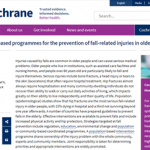This review of population-based programmes for the prevention of fall-related injuries in older people from McClure et al. was published in 2008.
Older people who live in institutions, such as assisted care facilities and nursing homes, and people over 80 years old are particularly likely to fall and injure themselves. Serious injuries include bone fracture, a head injury or tears to the skin (lacerations) that often require hospital treatment. Hip fractures almost always require hospitalisation and many community-dwelling individuals do not recover their ability to walk or carry out daily activities of living, which impacts greatly on their ability to live independently and their quality of life. Population studies show that hip fractures are the most serious fall-related injury in older people, with 15% dying in hospital and a third not surviving beyond one year afterwards.
The authors searched the Cochrane Injuries Group Specialised Register, CENTRAL (The Cochrane Library), MEDLINE, EMBASE, National Research Register, AgeInfo, PsycInfo and Web of Knowledge. They also searched the internet, carried out handsearches of selected journals and checked the reference lists of relevant papers to identify any further studies. 35 studies were identified, six met the criteria for inclusion and there were no randomised controlled trials.
Significant decreases or downward trends in fall-related injuries were reported in each of the included studies, with the relative reduction in fall-related injuries ranging from 6% to 33%.
The authors’ concluded that despite methodological limitations the consistency of reported reductions in fall-related injuries across all programmes support the preliminary claim that the population based approach to the prevention of fall-related injury is effective and can form the basis of public health practice.
Randomised multiple community trials of population based interventions are indicated to increase the level of evidence in support of the population based approach.
Further research is required to identify the barriers and facilitators in population based interventions and the degree to which they influence the efficacy of population based programmes.
Available at: Population-based programmes



